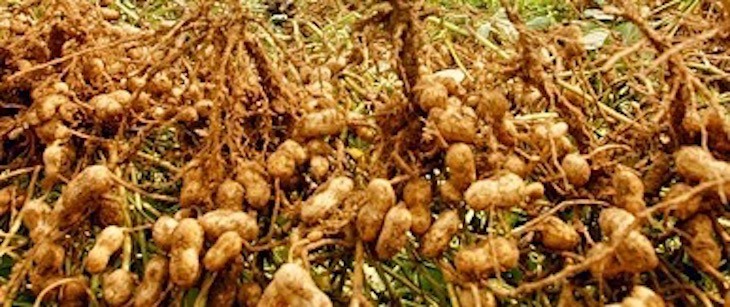Arkansas farmers set to harvest bumper peanut crop in 2017
by October 24, 2017 7:22 pm 1,585 views

Photo courtesy of John David Mercer.
Arkansas became a peanut growing state once again six years ago, and this year was one of the largest crops planted. Peanut farmers planted about 30,000 acres this year in Northeast Arkansas, a 6,000 acre uptick from the previous year, according to the United States Department of Agriculture.
More than half the crop is estimated to have been harvested. Removing peanuts from their fields is a long and laborious process, Craighead County Cooperative Extension Service Chair Branon Thiesse said. Peanuts have to be dug from the ground, allowed to dry, and then collected with a combine.
“Oh, it’s about like watching paint dry,” Thiesse said. “The harvest is moving along as fast as it can — at about one-and-a-half miles an hour. The combine that most people use is one that’s pulled by a tractor. The combine moves slowly, because in addition to the peanuts and the tops that are still connected to them, there’s also clods of dirt and things like that. The combine has to go real slow, so they can be separated out.”
Arkansas was a peanut producer up until the early 1980s. Peanut production shifted to other states like Georgia, Oklahoma, and Texas. Growing conditions and soil were two main reasons why the legume grew better in other states. It takes peanuts about five months to grow, and the plant prefers sandy soil. At the end of the process, peanuts have to be “turned” in the field, exposing them to wind and sun. This helps to dry the nuts before the harvest.
Northeast Arkansas has sandy soil in some areas, especially in Lawrence, Craighead, Mississippi, and other counties, but farmers were leery about fall weather in the region. It often turns cold in the area during the peanut harvest which can hurt yields. During the turn process rains can damage the crop and it’s a concern for farmers.
Travis Faske, extension plant pathologist and acting peanut agronomist for the University of Arkansas System Division of Agriculture, said the fact that peanuts can be unearthed at a much faster rate than they can be thrashed often leads to a production bottleneck. Beyond the technical challenges of harvesting the crop, Faske said the widespread use of irrigation in peanuts has essentially spared growers possible fallout from an exceedingly dry September.
“Peanuts aren’t terminated by cutting off the water, like we do with corn, soybeans and cotton,” Faske said. “Peanuts are terminated by digging. We don’t want them to get dry, but irrigation typically makes it a non-issue. We don’t have any dryland peanut fields in the state, but maybe a few dryland corners of a pivot field.”
There have been no widespread problems with this year’s crop, Lawrence County Cooperative Extension Chair Herb Ginn told Talk Business & Politics. The dry weather allowed farmers to work in the fields and irrigation helped to prepare the peanuts for harvest, he said. Some forms of blight have appeared in fields, but the disease hasn’t been widespread, and was isolated.
“It (disease) is something we have to keep an eye on. It’s not concerning at this point, but we always need to keep an eye on it,” he said.
Most peanuts are grown and sold on contract, which Faske said helps to somewhat insulate growers from market fluctuations. Contract prices in 2017 are averaging over $500 a ton, he said.
“The guys who are doing peanuts and cotton are smiling,” Faske said. “They’re having a good year, overall. Peanuts are definitely profitable again for the 2017 season.”
Georgia is the top peanut producing state in the country, with more than 730,000 planted acres this year, nearly 46% of the country’s total peanut acreage, according to the USDA. The legume has a $2 billion domestic retail market. It’s the 12th most valuable cash crop in the country, with a farm value of $1 billion in 2013, according to the American Peanut Council.
The United States grows about 10% of the world’s peanuts, about 29 million metric tons, according to the American Peanut Council. It’s the third largest peanut producer in the world, trailing only China and India. Each year the U.S. exports up to 250,000 metric tons of peanuts.
